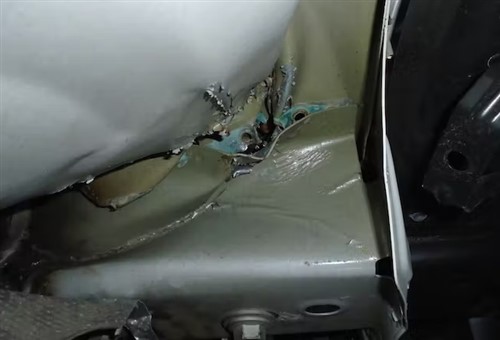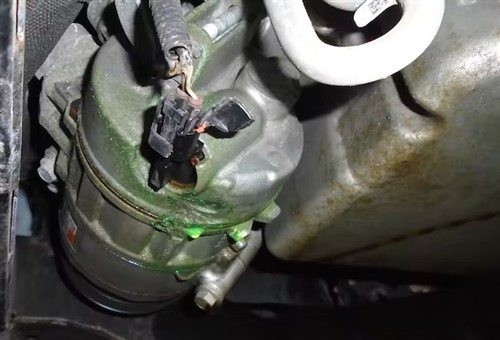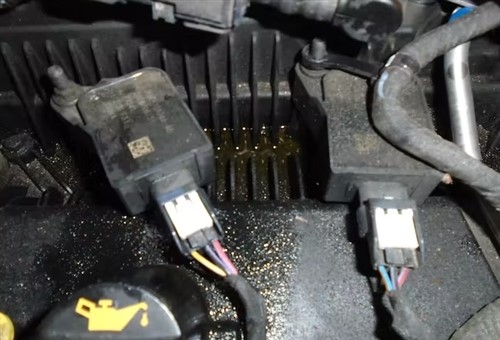
While the term “See The Big Picture” is somewhat hackneyed and overused in the worlds of business and marketing, our ability as mechanics and technicians to see and appreciate the Big (Diagnostic) Picture is now perhaps more pertinent to our approach to diagnostics than it has even been in the past.
We are not suggesting that taking a focused approach to diagnostic challenges is always wrong or counter-productive. What we are suggesting though, is that sometimes, we need to take a step back and consider a vehicle with defects for what it is- an incredibly complex amalgam of electrical, electronic, mechanical, and structural components that are (sometimes) integrated and interconnected in ways that are not always immediately clear or even logical.
We have all run into customer concerns with symptoms that do not seem to a) make sense or b) seem to fit the complaint. Thus, this article will discuss the importance of taking a “big picture” approach to diagnostics, as well as run through some cases of misdiagnoses made as a result of some workshops failing to “see the big picture”, diagnostically speaking.
We all make mistakes or sometimes overlook things, and this writer had overlooked his fair share of things over the years, but this article is not about pointing fingers. This article is about how misdiagnoses could be avoided but before we get to specifics, we should perhaps-
The internet abounds with articles that emphasise the need to obtain as much information about a customer's concerns from the customer directly because customers know their vehicles better than anybody else. We all know this and most of us even follow this advice, which is valid enough, but we also know that many customers have no clue how their vehicles work, or that symptoms are even present. Therefore, assuming that all customers a) always know their vehicles better than anybody else does, b) that customers are always able to describe symptoms accurately, or c) that customers always recognize sounds, smells, or vibrations as symptoms of a defect on their vehicles, is often a mistake.
The above may be preaching to the converted, but if you are new to the car repair industry in general, and to the independent car repair industry in particular, you should know that customers are NOT always the best sources of information when you are trying to formulate a strategy to diagnose or address concerns on their vehicles. In addition, while most of us know on some intuitive level that no two vehicles, even identical vehicles, wear or age in the same way, many of us often fail to include this very important fact in our diagnostic strategies.
We need not belabour the above points here, but suffice it to say that there are tried and tested methods of augmenting, as opposed to verifying, the sometimes-fragmented information we obtain from customers about their experience(s) of concerns they might have with their vehicles. Note that we are not suggesting that the information we obtain from customers is always suspect or never has diagnostic value: what we are suggesting, though, is that we sometimes do not test this information against our own observations when we attempt to replicate symptoms or concerns. So, what does all of the above mean in practice?
It simply means this: in many cases, we do not always ask the right questions to arrive at the right answer. Sure, we ask what the vehicle does, how often it does what it does, under what circumstances and operating conditions the vehicle does what it does, and even if what the vehicle does had been getting worse as of late, etc., etc., but when we view these questions objectively, we must admit that these questions seldom, if ever, produce the right answer. So, what is the right answer?
Well, that largely depends on the questions we (should) ask, but often don’t. Nonetheless, in all cases, the right answer is the one that explains a) the root cause(s) of the problem, as opposed to b) explaining the presence or manifestation of the symptoms a customer experiences. At first reading, these two propositions might appear to say the same thing but when one applies some logic or common sense to the problem, it turns out that the correlation between “a” and “b” merely explains the presence of the symptoms, as opposed to explaining the relationship between the root cause(s) of the problem, and the nature of the symptoms. (Italics added for emphasis)
Are you confused yet? Well, there is no need to be confused, because we can use a simple example to explain the above. Let us say you are presented with a vehicle on which the halogen headlights stopped working immediately after a battery replacement. You have no additional information, but as you investigate the issue, you find that the new battery had been integrated into the electrical system, but you also find that a relay between the headlights and the battery had failed, which explains the non-working headlights. As a result of your diagnosis, you replace the relay, which fails again immediately after you switch on the headlights.
While the failed relays explain why the headlights won’t work, you don’t know what caused both the original and the OEM-equivalent replacement relay to fail. Thus, in this (simplified) example, whatever caused the relays to fail would be the root cause of the headlights not working, with the nature of the symptoms being a defect or malfunction somewhere in the circuits that control the headlights. We can take this hypothetical situation a bit further: we could, for example, blame the original relay failure on a voltage spike caused by an improper jumpstart, based on the assumption that the battery was replaced because the original battery had died, but this does not explain the second relay failure.
We could also assume that a defect in the charging system had killed the original battery, and that evidence of this had been erased when all fault codes were cleared when the battery reset was performed. A charging system issue could perhaps explain both relay failures as a result of burnt or shorted wiring, but a battery reset typically aborts when a charging system is not in perfect working order.
We could take this example all the way to a failed or malfunctioning control module, but we are sure you get the point(s), which is that-
If you are new to the car repair industry, you will no doubt encounter many situations like the example described above as your career progresses. At the risk of coming across as patronizing, you will also be led down many deep and confusing diagnostic rabbit holes and you will doubt your abilities as a diagnostician many times. However, we stated elsewhere that are ways to minimize the frequency of such episodes, which are no more complicated than taking in the big picture and asking the right question, which in this case, is-
From a purely diagnostic perspective, this is a rather profound question because in many cases, it forces one to consider the whole vehicle as a complete system that is made up of many sub-systems that are not only inter-connected but also inter-dependent on one another for the larger system, i.e., the vehicle, to work as intended.
Let us illustrate this point by harking back to our hypothetically non-working headlights as described in the previous section. If we take the big picture approach, the headlights are just two components in a system that comprises the charging system, one or more control modules, the battery, multiple relays and fuses, one or more control switches, and probably about 100 metres of wiring, some of which may or may not include parts of a serial communications network. So how does the “big picture” approach apply to this example?
As a practical matter, the big picture would extend beyond just the parts and components listed above. For example, the big picture would include details like-
- perhaps most importantly, details on previous attempts to repair the current, or similar electrical concerns, if this information is available.
In practice though, asking the above questions will likely not reveal the root cause of the problems you are trying to diagnose, but considering a vehicle as a complete system and asking these questions will almost always point you in the right, or at least, the least wrong diagnostic direction. So, with that in mind, let us look at a few examples of misdiagnoses that this writer has first-hand knowledge of- all of which resulted from failures by technicians to consider the big picture, starting with the-
This tale involves a previously owned 2017 Ford SUV a customer had bought as a second vehicle a few days before a major rainstorm flooded the vehicle through the tailgate, so to discover why the tailgate leaked so badly, the customer took the vehicle to a local Ford specialist. The specialist could not find the problem, so he blithely recommended that the customer take the vehicle to a Ford-accredited body repairer who would "measure the vehicle’s body” as a first step to fixing the problem.
As a result of this advice, this writer’s workshop was the customer’s second port of call in trying to figure out why the tailgate leaked so badly. Our initial inspection showed that the tailgate was visibly out of alignment, and although OEM-service information revealed that, the tailgate’s hinges were adjustable, we could find no evidence in the form of witness marks that the hinges had somehow moved. In fact, the hinges had no free play, and they seemed to be in perfect condition, so why would the tailgate be out of alignment?
One obvious reason would be that the rear of the vehicle had been forced out of alignment during an accident, but in this case, there were no outward signs that the vehicle had ever suffered serious damage in an accident. Just to be sure about this, we put the vehicle on a lift to inspect the undercarriage for evidence of accident damage and found that the vehicle had indeed been in a rather serious accident, but only the outside of the vehicle had been repaired. Consider the image below-

Image source: https://www.vehicleservicepros.com/service-repair/diagnostics-and-drivability/article/21264517/big-picture-diagnostics
This image shows the area immediately behind the right-hand side of the bumper that had not been repaired. From this image, it is clear that the force of the accident was sufficient to crumple and bend a chassis beam, which explained why the rear of the vehicle was bent out of shape. In this case, the damage was just sufficient to prevent the tailgate’s sealing rubbers to keep water out of the vehicle, but not by so much that a casual inspection would show the tailgate to be seriously out of alignment. At this point, we also referred the customer to a specialist body repairer.
In this example, this writer’s staff scored a hugely embarrassing own goal. The vehicle involved was a slightly timeworn Ford Mustang Mach 1 that belonged to the treasurer of the local pigeon fancier’s club, which vehicle sported an aftermarket air conditioning system.
We did not install the A/C system, but we did install a new interior heater core before the A/C system was installed. Therefore, since we had worked on the cooling system, the treasurer brought the vehicle to us when he noticed a few drops of green liquid on his garage floor. Seeing that the engine coolant was green, the treasurer deduced that the cooling system must be leaking, and since we were the last workshop to work on the cooling system, we had to fix the leak.
This was a reasonable proposition, so the job fell to our most senior apprentice, who discovered some suspect hose clamps on the heater hoses. These were duly replaced, and the vehicle was handed back to its owner. However, three days later, the vehicle was back, with the owner complaining that the vehicle was still leaking green fluid, but also that the A/C system was not working as well as it used to. This time, the job fell to the diagnostician, who we have featured here before.
Long story short: the diagnostician, (who was going through an unusually quiet time just then) put the vehicle on a lift to inspect the parts of the big-block Ford V8 engine’s cooling system he could not see from above past the custom-built shroud around the radiator fans, and he found the actual problem almost immediately. Consider the image below-

Image source: https://www.vehicleservicepros.com/service-repair/diagnostics-and-drivability/article/21264517/big-picture-diagnostics
This image shows the actual leak, which was not from the cooling system, but from a defective, albeit (almost) new, A/C compressor. Notice both the location of the leak and the appearance of the fluid, whose colour is almost identical to that of the engine coolant.
The diagnostician stated that the origin of the leak was never in the cooling system, but in the compressor all along and after some research, we confirmed that the leak-detection dye used in this particular A/C system was indeed green. So, the leaking dye mimicked a leak from the cooling system, but had the apprenticed taken the big picture approach to this job by performing a thorough inspection of the vehicle, he would have noticed that it was the A/C compressor that was leaking dye, and not the cooling system leaking coolant.
Even though we scored an own goal on this job, we did discover the reason for the A/C system’s reduced performance, so this job did not turn out all bad.
This example involves yet another Ford; in this case, a 4-cylinder Ford Escape that belonged to the student daughter of a long-standing customer of ours.
The customer presented the vehicle with a severe “engine vibration” that appeared when accelerating at highway speeds. According to the customer, his daughter took the vehicle to a dealership in the city where she was attending university, and this dealership diagnosed a slipping torque converter clutch as the cause of the "vibration". Not knowing any better, the daughter authorized the hugely expensive torque converter replacement, but the "vibration" was still present and seemed to be getting worse.
The job of finding the cause of the vibration fell to a senior technician, who during his big-picture approach to the job, found that oil had seeped into the spark plug wells during an oil change. The oil had since turned the insulating spark plug boots on cylinders 1 and 2 into mush, which caused the spark plugs to misfire severely under high engine speeds and loads. Consider the image below that shows the spilled oil on the engine-

Image source: https://www.vehicleservicepros.com/service-repair/diagnostics-and-drivability/article/21264517/big-picture-diagnostics
Further investigation turned up the information that the daughter had the oil changed about 6 weeks before the engine vibration started, which gave the spilled oil plenty of time to destroy the rubber sparkplug boots. In fairness to the implicated dealership though, a badly slipping torque converter clutch will almost certainly cause the symptoms the daughter experienced, but had this dealership taken the big picture approach to this problem, they would almost certainly not have replaced the torque converter before digging a bit deeper into other possible causes of the vibration/misfire.
While there was nothing we could do about the unnecessary torque converter replacement, we fixed the engine vibration/misfire by removing the oil from the sparkplug wells and replacing the rubber boots on all four coils. Some weeks later, the customer reported that according to his daughter, the Escape was running well, and there were no longer any signs of vibrations of any kind- no matter how hard she accelerated, which leaves us with this-
We stated elsewhere in this article that we all make mistakes, which is true enough, but we can amplify this a bit by adding that almost all of our mistakes could have been avoided had we paid a bit more attention to how we approached the jobs that turned out badly.
With this in mind, this writer would like to suggest that we can greatly reduce the number of mistakes, misdiagnoses, and comebacks we make and see simply by adopting a consistently rational and logical approach to diagnostic challenges. Instead of a narrow focus on the symptoms we see (which do not always tell the whole story), we should perhaps focus more broadly on the interconnectedness of all the systems that make a vehicle work.
In other words, we should perhaps pay more attention to the big picture to get a more complete overview of a vehicle as a whole, even before we touch a scan tool or spanner to investigate symptoms, as opposed to investigating the nature of whatever problems a customer might have with a vehicle.